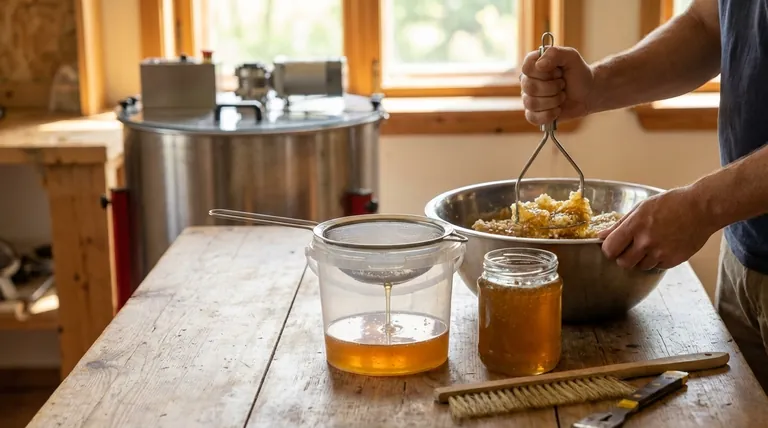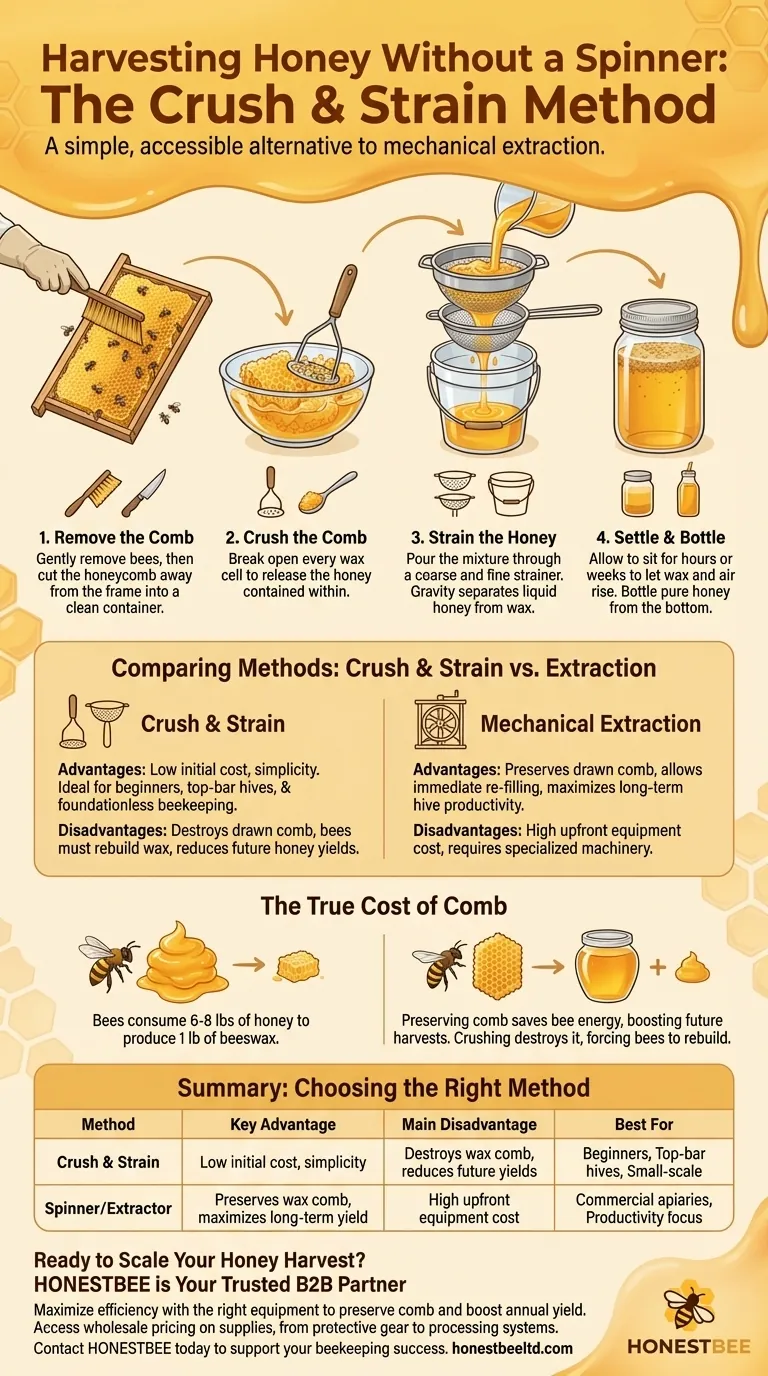Yes, you can absolutely harvest honey without a spinner, which is more formally known as a honey extractor. The most common and accessible alternative is the "crush and strain" method. This technique involves removing the entire honeycomb from the frame, crushing it to release the honey, and then straining the mixture to separate the liquid honey from the beeswax.
The decision between using an extractor and the crush and strain method boils down to a fundamental trade-off: Crush and strain prioritizes simplicity and low initial cost at the expense of the beeswax comb, while extraction prioritizes long-term hive productivity and efficiency but requires a significant equipment investment.

The Crush and Strain Method Explained
The crush and strain technique is as straightforward as its name implies. It is the oldest and most basic way to separate honey from comb and requires no specialized or expensive machinery.
Step 1: Remove the Comb
First, you must gently remove the bees from the honey frames using a tool like a bee brush. Once the frame is clear, use a hive tool or a simple knife to cut or scrape the entire honeycomb away from the wooden frame. The comb is collected in a clean, food-grade bucket or large bowl.
Step 2: Crush the Comb
Using a potato masher, a large spoon, or even clean hands, crush the honeycomb thoroughly. The goal is to break open every wax cell to release the honey contained within.
Step 3: Strain the Honey
Pour the crushed mixture of honey and wax into a strainer system. You can create a simple setup by placing a coarse strainer over a fine strainer, all resting on top of a clean bottling bucket or container. Gravity will do most of the work.
Step 4: Settle and Bottle
Allow the honey to sit for a few hours, or even a couple of weeks, in a sealed container. During this time, any remaining fine wax particles and air bubbles will rise to the top. You can then bottle the pure honey from the bottom of the container, leaving the sediment behind.
Comparing Methods: Crush and Strain vs. Extraction
While both methods yield pure honey, they have profoundly different impacts on your bees and your beekeeping operation.
The Case for Crush and Strain
The primary advantages of this method are its simplicity and low cost. There is no need to purchase an extractor, which can be one of the most expensive pieces of beekeeping equipment. This makes it an ideal entry point for beginners or those with only one or two hives.
The Case for Mechanical Extraction
Using a spinner or extractor preserves the drawn comb. After the honey is spun out, the empty but intact wax frames are returned to the hive. This gives the bees a massive head start for the next season.
Understanding the Trade-offs: The True Cost of Comb
The choice to crush your comb is not without consequences for the hive. Understanding this is critical to making an informed decision.
Bee Energy and Wax Production
Bees must expend a tremendous amount of energy to produce wax. It is estimated that bees consume 6 to 8 pounds of honey to produce just one pound of beeswax. When you use the crush and strain method, you are destroying this valuable, energy-intensive resource.
The Impact on Future Harvests
When you give bees back their empty, drawn-out comb after extraction, they can immediately begin refilling it with new honey. When you force them to rebuild the entire comb from scratch, they must divert energy from foraging and honey production to wax creation. This can significantly reduce the potential size of your next honey harvest.
When Crush and Strain Still Makes Sense
This method is the standard and most logical choice for top-bar hives or foundationless beekeeping, where frames are not designed for extraction. It is also the only option for dealing with "cross comb"—comb that is built irregularly across multiple frames and cannot fit into an extractor.
Making the Right Choice for Your Goal
Your beekeeping philosophy and operational scale should guide your decision. There is no single "correct" answer, only the one that is right for you.
- If your primary focus is your first harvest or minimal investment: Crush and strain is the ideal starting point to get pure, delicious honey without a large upfront cost.
- If your primary focus is maximizing long-term honey yield: Investing in an extractor is necessary to preserve the drawn comb and support higher hive productivity year after year.
- If your primary focus is natural or top-bar beekeeping: The crush and strain method aligns perfectly with the philosophy of these systems and is the most practical choice.
Ultimately, choose the method that best aligns with your resources, your goals, and the needs of your bees.
Summary Table:
| Method | Key Advantage | Main Disadvantage | Best For |
|---|---|---|---|
| Crush and Strain | Low initial cost, simplicity | Destroys wax comb, reduces future yields | Beginners, top-bar hives, small-scale beekeepers |
| Spinner/Extractor | Preserves wax comb, maximizes long-term yield | High upfront equipment cost | Commercial apiaries, beekeepers focused on productivity |
Ready to scale your honey harvest?
Whether you're starting with the crush and strain method or ready to upgrade to a commercial extractor, HONESTBEE is your trusted partner. We supply durable, high-performance beekeeping supplies and equipment to commercial apiaries and distributors through our wholesale-focused operations.
- Maximize Efficiency: Get the right equipment to preserve comb and boost your annual yield.
- Grow Your Operation: Access wholesale pricing on everything from protective gear to honey processing systems.
Contact HONESTBEE today to discuss your needs and discover how our equipment can support your beekeeping success.
Visual Guide

Related Products
- Electric 8 Frame Honey Spinner Extractor Equipment for Beekeeping
- HONESTBEE 3-Frame Manual Acrylic Honey Extractor
- HONESTBEE 72 Frame Industrial Electric Honey Extractor for Beekeeping
- 2 Frame Stainless Steel Manual Honey Spinner Extractor for Beekeeping
- 8-Frame Electric Self-Reversing Honey Extractor Spinner for Commercial Honey Extraction Equipment
People Also Ask
- What are the benefits of using a honey extractor? Maximize Harvest & Save Bee Energy
- How long should you spin honey? Master the Art of Efficient, Damage-Free Extraction
- What are the best storage conditions for a honey extractor? Protect Your Investment for Next Season
- What equipment is needed for extracting honey? A Complete Guide for Every Beekeeper
- How long should you spin honey for? Master the Art of Efficient, Safe Extraction



















